Comprehensive Analysis of Palliative and Rehabilitation Care Report
VerifiedAdded on 2020/03/16
|9
|2543
|78
Report
AI Summary
This report provides a comprehensive overview of palliative and rehabilitation care, defining key concepts and principles as outlined by the World Health Organization. It emphasizes the holistic approach to patient care, including psychological, spiritual, and social aspects, particularly for those with chronic illnesses or disabilities. The report details the principles of palliative care, such as affirming life, pain management, and support for patients and families. It also explores rehabilitation concepts, focusing on patient independence and self-determination. The report further examines the New Zealand rehabilitation system, its strategies, and its aim to improve health outcomes for individuals with disabilities. A case study of a 68-year-old patient with prostate cancer, Jimmy McGregor, is used to illustrate the application of these principles and highlight areas where care could be improved, such as continuity of care, psychosocial support, and advanced care planning. The report concludes by emphasizing the importance of coordinated, comprehensive care and the ongoing need for improvements in palliative and rehabilitation services, particularly in the context of the New Zealand healthcare system.
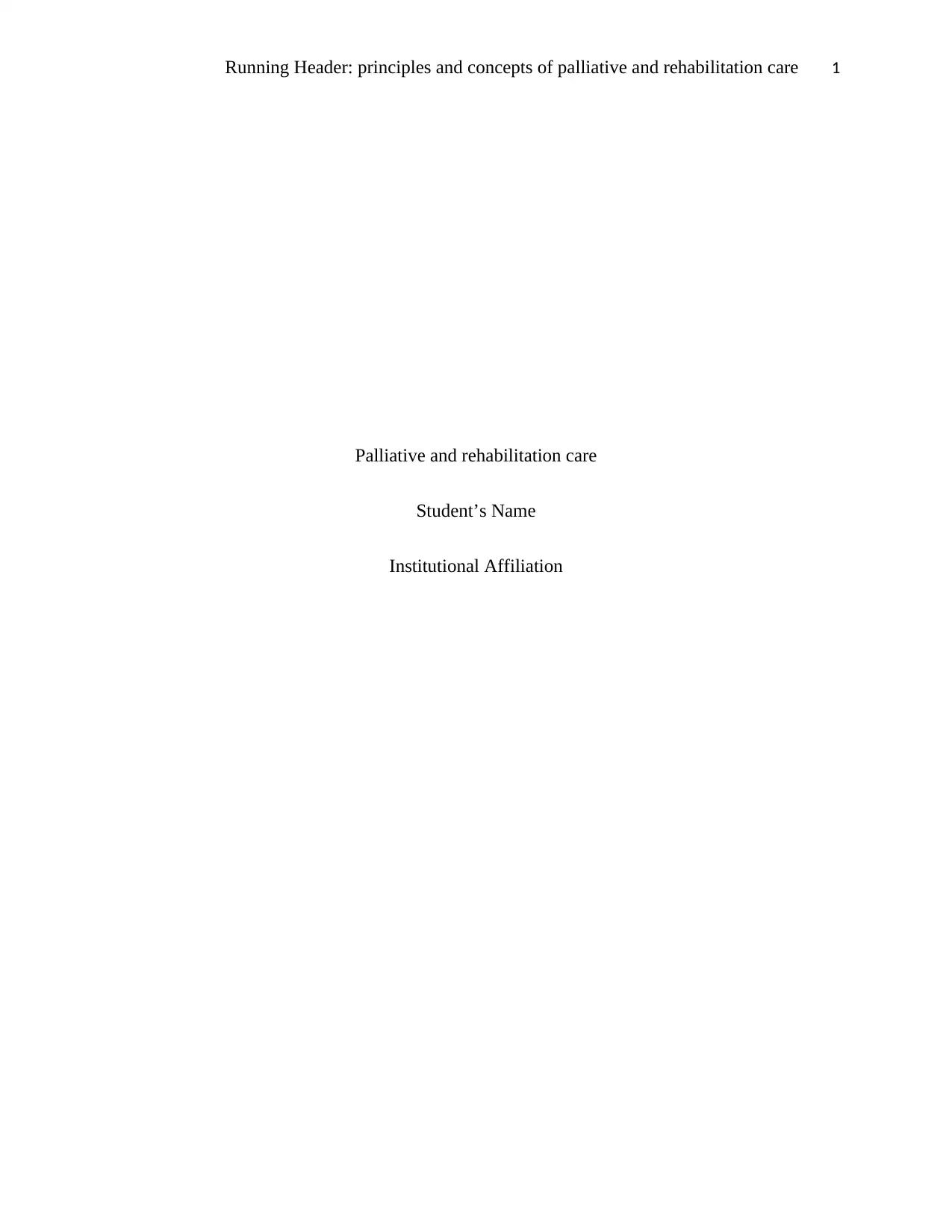
Running Header: principles and concepts of palliative and rehabilitation care 1
Palliative and rehabilitation care
Student’s Name
Institutional Affiliation
Palliative and rehabilitation care
Student’s Name
Institutional Affiliation
Paraphrase This Document
Need a fresh take? Get an instant paraphrase of this document with our AI Paraphraser
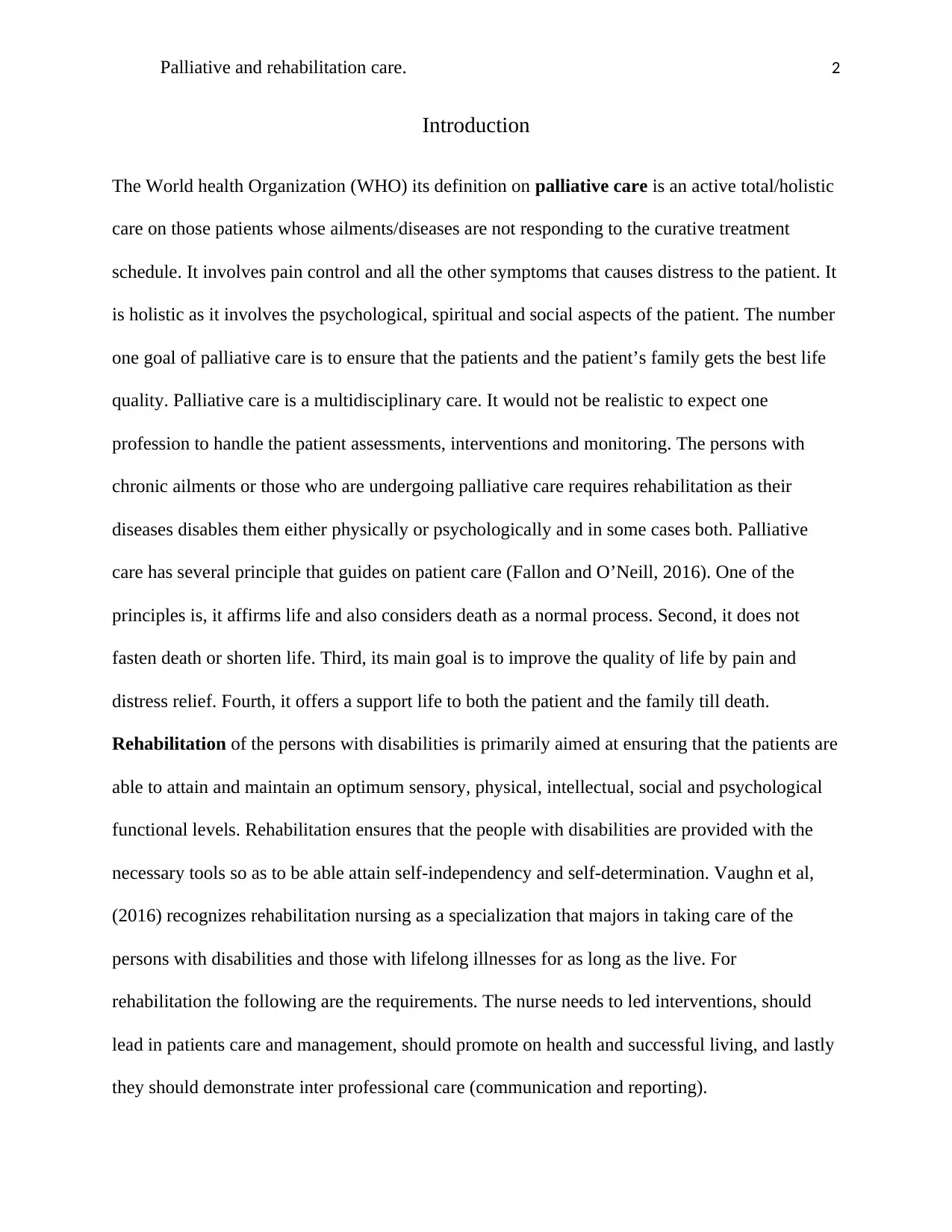
Palliative and rehabilitation care. 2
Introduction
The World health Organization (WHO) its definition on palliative care is an active total/holistic
care on those patients whose ailments/diseases are not responding to the curative treatment
schedule. It involves pain control and all the other symptoms that causes distress to the patient. It
is holistic as it involves the psychological, spiritual and social aspects of the patient. The number
one goal of palliative care is to ensure that the patients and the patient’s family gets the best life
quality. Palliative care is a multidisciplinary care. It would not be realistic to expect one
profession to handle the patient assessments, interventions and monitoring. The persons with
chronic ailments or those who are undergoing palliative care requires rehabilitation as their
diseases disables them either physically or psychologically and in some cases both. Palliative
care has several principle that guides on patient care (Fallon and O’Neill, 2016). One of the
principles is, it affirms life and also considers death as a normal process. Second, it does not
fasten death or shorten life. Third, its main goal is to improve the quality of life by pain and
distress relief. Fourth, it offers a support life to both the patient and the family till death.
Rehabilitation of the persons with disabilities is primarily aimed at ensuring that the patients are
able to attain and maintain an optimum sensory, physical, intellectual, social and psychological
functional levels. Rehabilitation ensures that the people with disabilities are provided with the
necessary tools so as to be able attain self-independency and self-determination. Vaughn et al,
(2016) recognizes rehabilitation nursing as a specialization that majors in taking care of the
persons with disabilities and those with lifelong illnesses for as long as the live. For
rehabilitation the following are the requirements. The nurse needs to led interventions, should
lead in patients care and management, should promote on health and successful living, and lastly
they should demonstrate inter professional care (communication and reporting).
Introduction
The World health Organization (WHO) its definition on palliative care is an active total/holistic
care on those patients whose ailments/diseases are not responding to the curative treatment
schedule. It involves pain control and all the other symptoms that causes distress to the patient. It
is holistic as it involves the psychological, spiritual and social aspects of the patient. The number
one goal of palliative care is to ensure that the patients and the patient’s family gets the best life
quality. Palliative care is a multidisciplinary care. It would not be realistic to expect one
profession to handle the patient assessments, interventions and monitoring. The persons with
chronic ailments or those who are undergoing palliative care requires rehabilitation as their
diseases disables them either physically or psychologically and in some cases both. Palliative
care has several principle that guides on patient care (Fallon and O’Neill, 2016). One of the
principles is, it affirms life and also considers death as a normal process. Second, it does not
fasten death or shorten life. Third, its main goal is to improve the quality of life by pain and
distress relief. Fourth, it offers a support life to both the patient and the family till death.
Rehabilitation of the persons with disabilities is primarily aimed at ensuring that the patients are
able to attain and maintain an optimum sensory, physical, intellectual, social and psychological
functional levels. Rehabilitation ensures that the people with disabilities are provided with the
necessary tools so as to be able attain self-independency and self-determination. Vaughn et al,
(2016) recognizes rehabilitation nursing as a specialization that majors in taking care of the
persons with disabilities and those with lifelong illnesses for as long as the live. For
rehabilitation the following are the requirements. The nurse needs to led interventions, should
lead in patients care and management, should promote on health and successful living, and lastly
they should demonstrate inter professional care (communication and reporting).
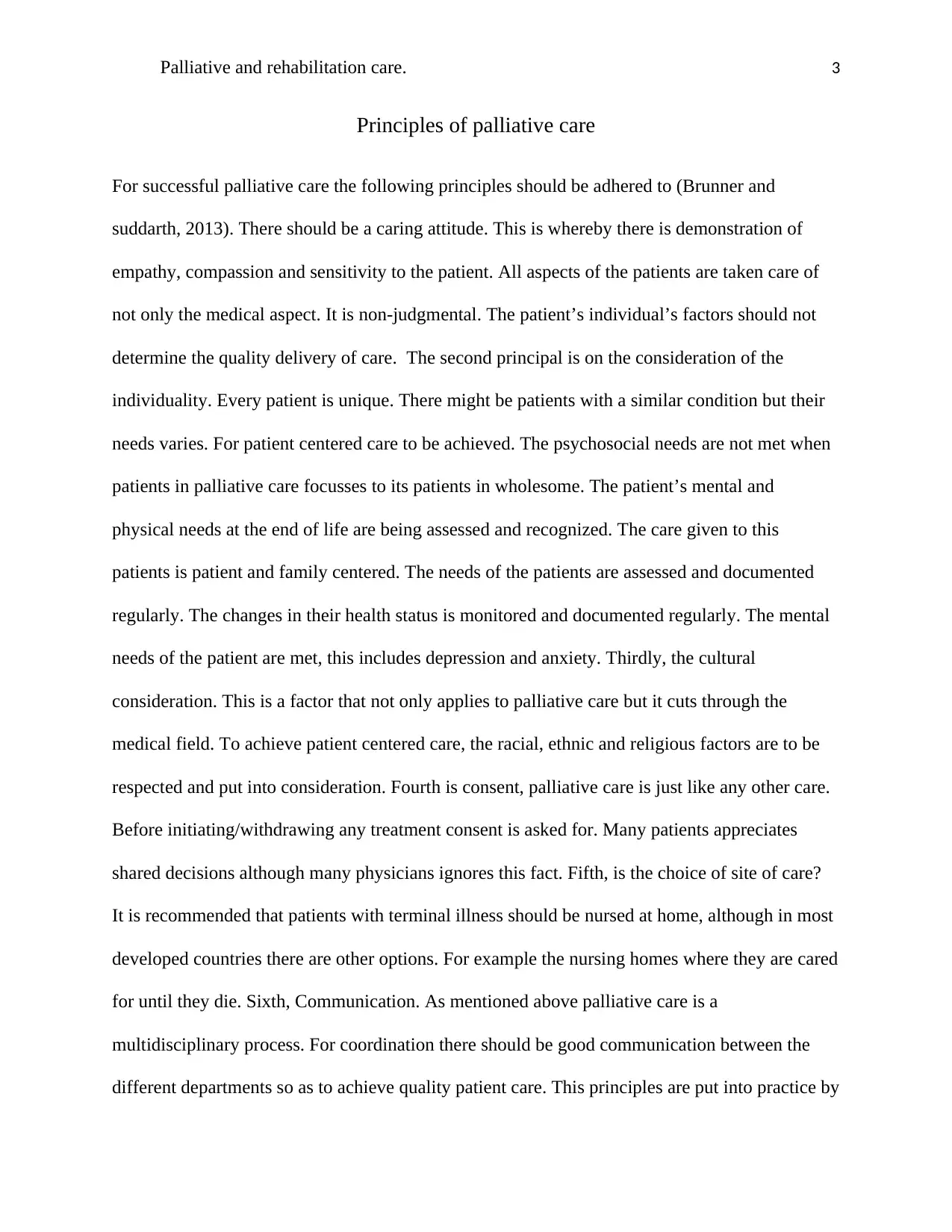
Palliative and rehabilitation care. 3
Principles of palliative care
For successful palliative care the following principles should be adhered to (Brunner and
suddarth, 2013). There should be a caring attitude. This is whereby there is demonstration of
empathy, compassion and sensitivity to the patient. All aspects of the patients are taken care of
not only the medical aspect. It is non-judgmental. The patient’s individual’s factors should not
determine the quality delivery of care. The second principal is on the consideration of the
individuality. Every patient is unique. There might be patients with a similar condition but their
needs varies. For patient centered care to be achieved. The psychosocial needs are not met when
patients in palliative care focusses to its patients in wholesome. The patient’s mental and
physical needs at the end of life are being assessed and recognized. The care given to this
patients is patient and family centered. The needs of the patients are assessed and documented
regularly. The changes in their health status is monitored and documented regularly. The mental
needs of the patient are met, this includes depression and anxiety. Thirdly, the cultural
consideration. This is a factor that not only applies to palliative care but it cuts through the
medical field. To achieve patient centered care, the racial, ethnic and religious factors are to be
respected and put into consideration. Fourth is consent, palliative care is just like any other care.
Before initiating/withdrawing any treatment consent is asked for. Many patients appreciates
shared decisions although many physicians ignores this fact. Fifth, is the choice of site of care?
It is recommended that patients with terminal illness should be nursed at home, although in most
developed countries there are other options. For example the nursing homes where they are cared
for until they die. Sixth, Communication. As mentioned above palliative care is a
multidisciplinary process. For coordination there should be good communication between the
different departments so as to achieve quality patient care. This principles are put into practice by
Principles of palliative care
For successful palliative care the following principles should be adhered to (Brunner and
suddarth, 2013). There should be a caring attitude. This is whereby there is demonstration of
empathy, compassion and sensitivity to the patient. All aspects of the patients are taken care of
not only the medical aspect. It is non-judgmental. The patient’s individual’s factors should not
determine the quality delivery of care. The second principal is on the consideration of the
individuality. Every patient is unique. There might be patients with a similar condition but their
needs varies. For patient centered care to be achieved. The psychosocial needs are not met when
patients in palliative care focusses to its patients in wholesome. The patient’s mental and
physical needs at the end of life are being assessed and recognized. The care given to this
patients is patient and family centered. The needs of the patients are assessed and documented
regularly. The changes in their health status is monitored and documented regularly. The mental
needs of the patient are met, this includes depression and anxiety. Thirdly, the cultural
consideration. This is a factor that not only applies to palliative care but it cuts through the
medical field. To achieve patient centered care, the racial, ethnic and religious factors are to be
respected and put into consideration. Fourth is consent, palliative care is just like any other care.
Before initiating/withdrawing any treatment consent is asked for. Many patients appreciates
shared decisions although many physicians ignores this fact. Fifth, is the choice of site of care?
It is recommended that patients with terminal illness should be nursed at home, although in most
developed countries there are other options. For example the nursing homes where they are cared
for until they die. Sixth, Communication. As mentioned above palliative care is a
multidisciplinary process. For coordination there should be good communication between the
different departments so as to achieve quality patient care. This principles are put into practice by
⊘ This is a preview!⊘
Do you want full access?
Subscribe today to unlock all pages.

Trusted by 1+ million students worldwide
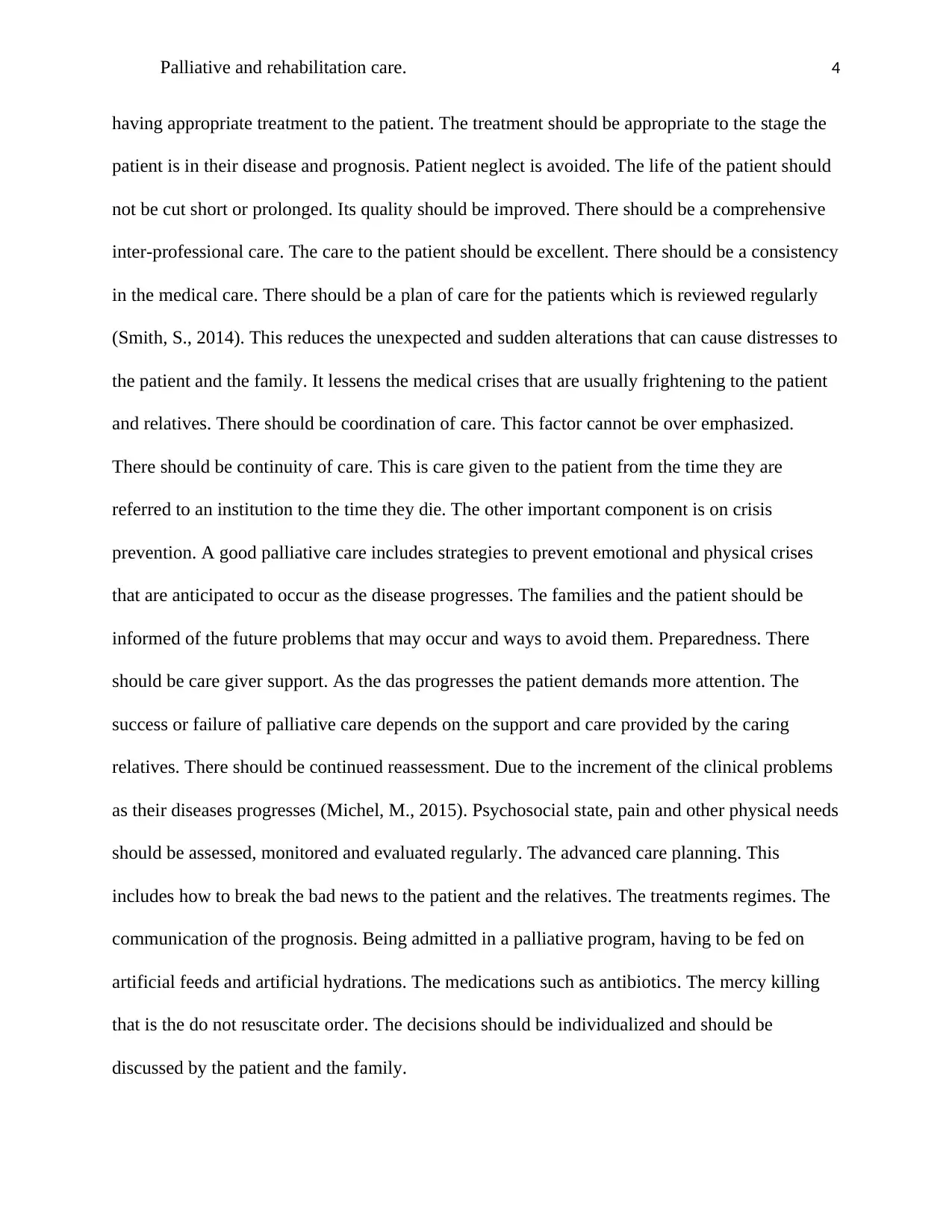
Palliative and rehabilitation care. 4
having appropriate treatment to the patient. The treatment should be appropriate to the stage the
patient is in their disease and prognosis. Patient neglect is avoided. The life of the patient should
not be cut short or prolonged. Its quality should be improved. There should be a comprehensive
inter-professional care. The care to the patient should be excellent. There should be a consistency
in the medical care. There should be a plan of care for the patients which is reviewed regularly
(Smith, S., 2014). This reduces the unexpected and sudden alterations that can cause distresses to
the patient and the family. It lessens the medical crises that are usually frightening to the patient
and relatives. There should be coordination of care. This factor cannot be over emphasized.
There should be continuity of care. This is care given to the patient from the time they are
referred to an institution to the time they die. The other important component is on crisis
prevention. A good palliative care includes strategies to prevent emotional and physical crises
that are anticipated to occur as the disease progresses. The families and the patient should be
informed of the future problems that may occur and ways to avoid them. Preparedness. There
should be care giver support. As the das progresses the patient demands more attention. The
success or failure of palliative care depends on the support and care provided by the caring
relatives. There should be continued reassessment. Due to the increment of the clinical problems
as their diseases progresses (Michel, M., 2015). Psychosocial state, pain and other physical needs
should be assessed, monitored and evaluated regularly. The advanced care planning. This
includes how to break the bad news to the patient and the relatives. The treatments regimes. The
communication of the prognosis. Being admitted in a palliative program, having to be fed on
artificial feeds and artificial hydrations. The medications such as antibiotics. The mercy killing
that is the do not resuscitate order. The decisions should be individualized and should be
discussed by the patient and the family.
having appropriate treatment to the patient. The treatment should be appropriate to the stage the
patient is in their disease and prognosis. Patient neglect is avoided. The life of the patient should
not be cut short or prolonged. Its quality should be improved. There should be a comprehensive
inter-professional care. The care to the patient should be excellent. There should be a consistency
in the medical care. There should be a plan of care for the patients which is reviewed regularly
(Smith, S., 2014). This reduces the unexpected and sudden alterations that can cause distresses to
the patient and the family. It lessens the medical crises that are usually frightening to the patient
and relatives. There should be coordination of care. This factor cannot be over emphasized.
There should be continuity of care. This is care given to the patient from the time they are
referred to an institution to the time they die. The other important component is on crisis
prevention. A good palliative care includes strategies to prevent emotional and physical crises
that are anticipated to occur as the disease progresses. The families and the patient should be
informed of the future problems that may occur and ways to avoid them. Preparedness. There
should be care giver support. As the das progresses the patient demands more attention. The
success or failure of palliative care depends on the support and care provided by the caring
relatives. There should be continued reassessment. Due to the increment of the clinical problems
as their diseases progresses (Michel, M., 2015). Psychosocial state, pain and other physical needs
should be assessed, monitored and evaluated regularly. The advanced care planning. This
includes how to break the bad news to the patient and the relatives. The treatments regimes. The
communication of the prognosis. Being admitted in a palliative program, having to be fed on
artificial feeds and artificial hydrations. The medications such as antibiotics. The mercy killing
that is the do not resuscitate order. The decisions should be individualized and should be
discussed by the patient and the family.
Paraphrase This Document
Need a fresh take? Get an instant paraphrase of this document with our AI Paraphraser
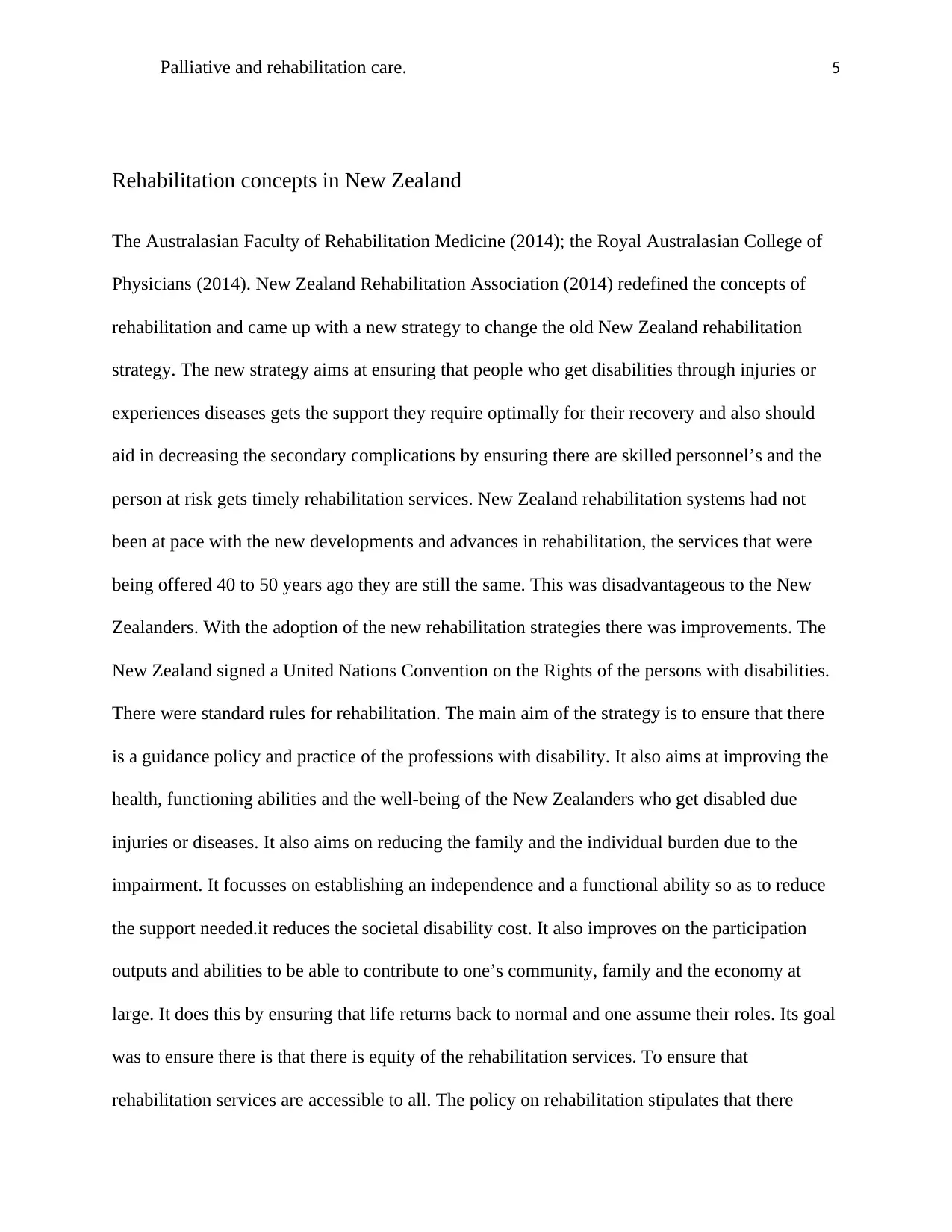
Palliative and rehabilitation care. 5
Rehabilitation concepts in New Zealand
The Australasian Faculty of Rehabilitation Medicine (2014); the Royal Australasian College of
Physicians (2014). New Zealand Rehabilitation Association (2014) redefined the concepts of
rehabilitation and came up with a new strategy to change the old New Zealand rehabilitation
strategy. The new strategy aims at ensuring that people who get disabilities through injuries or
experiences diseases gets the support they require optimally for their recovery and also should
aid in decreasing the secondary complications by ensuring there are skilled personnel’s and the
person at risk gets timely rehabilitation services. New Zealand rehabilitation systems had not
been at pace with the new developments and advances in rehabilitation, the services that were
being offered 40 to 50 years ago they are still the same. This was disadvantageous to the New
Zealanders. With the adoption of the new rehabilitation strategies there was improvements. The
New Zealand signed a United Nations Convention on the Rights of the persons with disabilities.
There were standard rules for rehabilitation. The main aim of the strategy is to ensure that there
is a guidance policy and practice of the professions with disability. It also aims at improving the
health, functioning abilities and the well-being of the New Zealanders who get disabled due
injuries or diseases. It also aims on reducing the family and the individual burden due to the
impairment. It focusses on establishing an independence and a functional ability so as to reduce
the support needed.it reduces the societal disability cost. It also improves on the participation
outputs and abilities to be able to contribute to one’s community, family and the economy at
large. It does this by ensuring that life returns back to normal and one assume their roles. Its goal
was to ensure there is that there is equity of the rehabilitation services. To ensure that
rehabilitation services are accessible to all. The policy on rehabilitation stipulates that there
Rehabilitation concepts in New Zealand
The Australasian Faculty of Rehabilitation Medicine (2014); the Royal Australasian College of
Physicians (2014). New Zealand Rehabilitation Association (2014) redefined the concepts of
rehabilitation and came up with a new strategy to change the old New Zealand rehabilitation
strategy. The new strategy aims at ensuring that people who get disabilities through injuries or
experiences diseases gets the support they require optimally for their recovery and also should
aid in decreasing the secondary complications by ensuring there are skilled personnel’s and the
person at risk gets timely rehabilitation services. New Zealand rehabilitation systems had not
been at pace with the new developments and advances in rehabilitation, the services that were
being offered 40 to 50 years ago they are still the same. This was disadvantageous to the New
Zealanders. With the adoption of the new rehabilitation strategies there was improvements. The
New Zealand signed a United Nations Convention on the Rights of the persons with disabilities.
There were standard rules for rehabilitation. The main aim of the strategy is to ensure that there
is a guidance policy and practice of the professions with disability. It also aims at improving the
health, functioning abilities and the well-being of the New Zealanders who get disabled due
injuries or diseases. It also aims on reducing the family and the individual burden due to the
impairment. It focusses on establishing an independence and a functional ability so as to reduce
the support needed.it reduces the societal disability cost. It also improves on the participation
outputs and abilities to be able to contribute to one’s community, family and the economy at
large. It does this by ensuring that life returns back to normal and one assume their roles. Its goal
was to ensure there is that there is equity of the rehabilitation services. To ensure that
rehabilitation services are accessible to all. The policy on rehabilitation stipulates that there
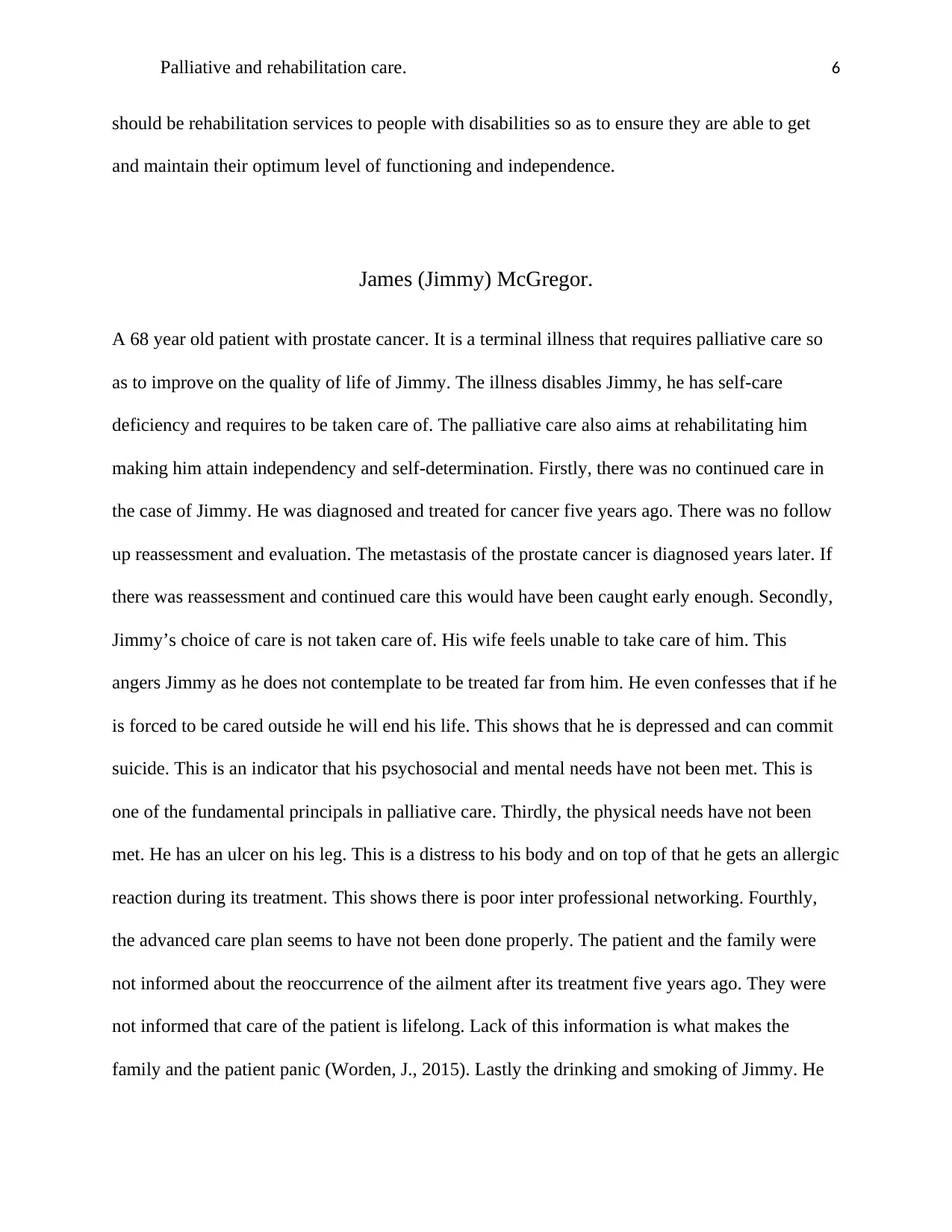
Palliative and rehabilitation care. 6
should be rehabilitation services to people with disabilities so as to ensure they are able to get
and maintain their optimum level of functioning and independence.
James (Jimmy) McGregor.
A 68 year old patient with prostate cancer. It is a terminal illness that requires palliative care so
as to improve on the quality of life of Jimmy. The illness disables Jimmy, he has self-care
deficiency and requires to be taken care of. The palliative care also aims at rehabilitating him
making him attain independency and self-determination. Firstly, there was no continued care in
the case of Jimmy. He was diagnosed and treated for cancer five years ago. There was no follow
up reassessment and evaluation. The metastasis of the prostate cancer is diagnosed years later. If
there was reassessment and continued care this would have been caught early enough. Secondly,
Jimmy’s choice of care is not taken care of. His wife feels unable to take care of him. This
angers Jimmy as he does not contemplate to be treated far from him. He even confesses that if he
is forced to be cared outside he will end his life. This shows that he is depressed and can commit
suicide. This is an indicator that his psychosocial and mental needs have not been met. This is
one of the fundamental principals in palliative care. Thirdly, the physical needs have not been
met. He has an ulcer on his leg. This is a distress to his body and on top of that he gets an allergic
reaction during its treatment. This shows there is poor inter professional networking. Fourthly,
the advanced care plan seems to have not been done properly. The patient and the family were
not informed about the reoccurrence of the ailment after its treatment five years ago. They were
not informed that care of the patient is lifelong. Lack of this information is what makes the
family and the patient panic (Worden, J., 2015). Lastly the drinking and smoking of Jimmy. He
should be rehabilitation services to people with disabilities so as to ensure they are able to get
and maintain their optimum level of functioning and independence.
James (Jimmy) McGregor.
A 68 year old patient with prostate cancer. It is a terminal illness that requires palliative care so
as to improve on the quality of life of Jimmy. The illness disables Jimmy, he has self-care
deficiency and requires to be taken care of. The palliative care also aims at rehabilitating him
making him attain independency and self-determination. Firstly, there was no continued care in
the case of Jimmy. He was diagnosed and treated for cancer five years ago. There was no follow
up reassessment and evaluation. The metastasis of the prostate cancer is diagnosed years later. If
there was reassessment and continued care this would have been caught early enough. Secondly,
Jimmy’s choice of care is not taken care of. His wife feels unable to take care of him. This
angers Jimmy as he does not contemplate to be treated far from him. He even confesses that if he
is forced to be cared outside he will end his life. This shows that he is depressed and can commit
suicide. This is an indicator that his psychosocial and mental needs have not been met. This is
one of the fundamental principals in palliative care. Thirdly, the physical needs have not been
met. He has an ulcer on his leg. This is a distress to his body and on top of that he gets an allergic
reaction during its treatment. This shows there is poor inter professional networking. Fourthly,
the advanced care plan seems to have not been done properly. The patient and the family were
not informed about the reoccurrence of the ailment after its treatment five years ago. They were
not informed that care of the patient is lifelong. Lack of this information is what makes the
family and the patient panic (Worden, J., 2015). Lastly the drinking and smoking of Jimmy. He
⊘ This is a preview!⊘
Do you want full access?
Subscribe today to unlock all pages.

Trusted by 1+ million students worldwide
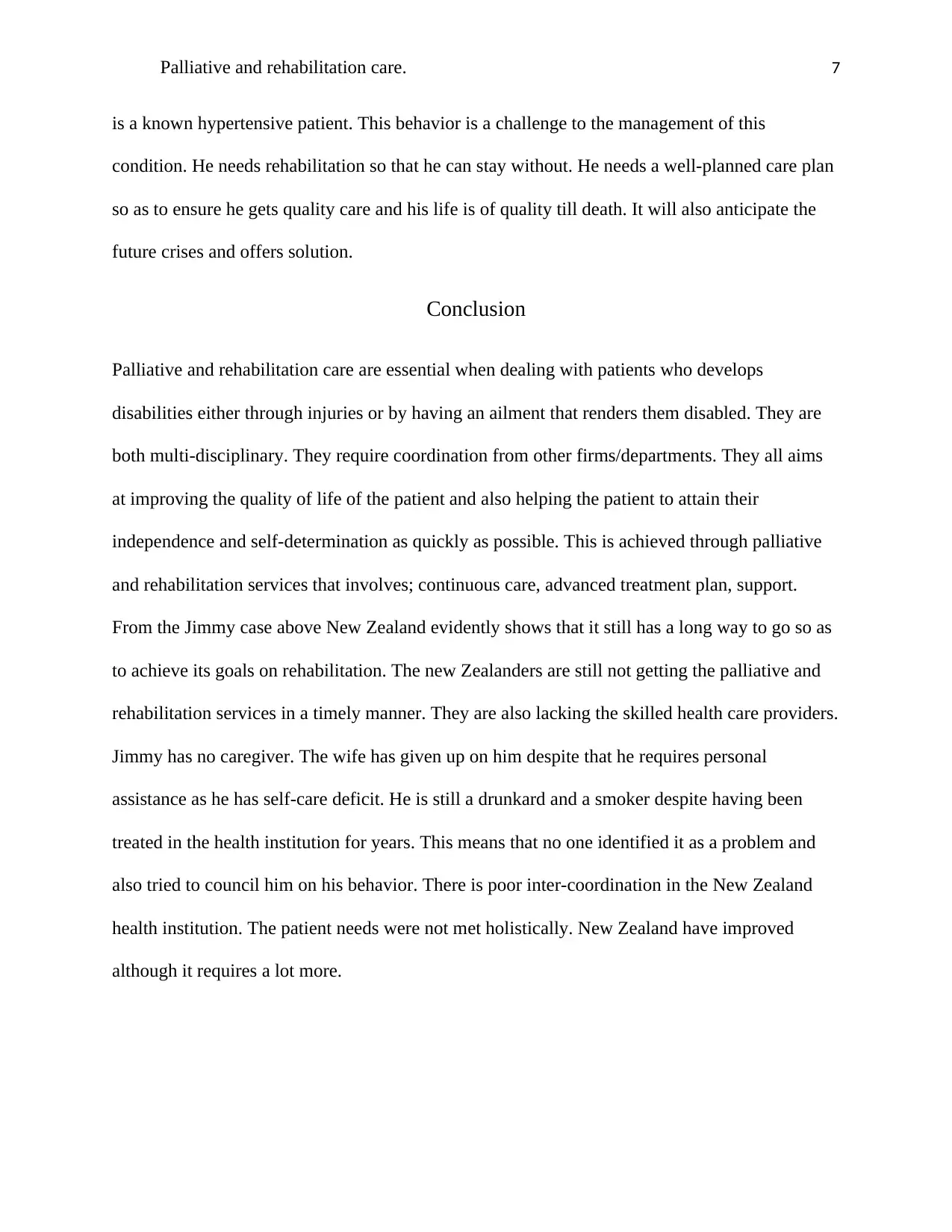
Palliative and rehabilitation care. 7
is a known hypertensive patient. This behavior is a challenge to the management of this
condition. He needs rehabilitation so that he can stay without. He needs a well-planned care plan
so as to ensure he gets quality care and his life is of quality till death. It will also anticipate the
future crises and offers solution.
Conclusion
Palliative and rehabilitation care are essential when dealing with patients who develops
disabilities either through injuries or by having an ailment that renders them disabled. They are
both multi-disciplinary. They require coordination from other firms/departments. They all aims
at improving the quality of life of the patient and also helping the patient to attain their
independence and self-determination as quickly as possible. This is achieved through palliative
and rehabilitation services that involves; continuous care, advanced treatment plan, support.
From the Jimmy case above New Zealand evidently shows that it still has a long way to go so as
to achieve its goals on rehabilitation. The new Zealanders are still not getting the palliative and
rehabilitation services in a timely manner. They are also lacking the skilled health care providers.
Jimmy has no caregiver. The wife has given up on him despite that he requires personal
assistance as he has self-care deficit. He is still a drunkard and a smoker despite having been
treated in the health institution for years. This means that no one identified it as a problem and
also tried to council him on his behavior. There is poor inter-coordination in the New Zealand
health institution. The patient needs were not met holistically. New Zealand have improved
although it requires a lot more.
is a known hypertensive patient. This behavior is a challenge to the management of this
condition. He needs rehabilitation so that he can stay without. He needs a well-planned care plan
so as to ensure he gets quality care and his life is of quality till death. It will also anticipate the
future crises and offers solution.
Conclusion
Palliative and rehabilitation care are essential when dealing with patients who develops
disabilities either through injuries or by having an ailment that renders them disabled. They are
both multi-disciplinary. They require coordination from other firms/departments. They all aims
at improving the quality of life of the patient and also helping the patient to attain their
independence and self-determination as quickly as possible. This is achieved through palliative
and rehabilitation services that involves; continuous care, advanced treatment plan, support.
From the Jimmy case above New Zealand evidently shows that it still has a long way to go so as
to achieve its goals on rehabilitation. The new Zealanders are still not getting the palliative and
rehabilitation services in a timely manner. They are also lacking the skilled health care providers.
Jimmy has no caregiver. The wife has given up on him despite that he requires personal
assistance as he has self-care deficit. He is still a drunkard and a smoker despite having been
treated in the health institution for years. This means that no one identified it as a problem and
also tried to council him on his behavior. There is poor inter-coordination in the New Zealand
health institution. The patient needs were not met holistically. New Zealand have improved
although it requires a lot more.
Paraphrase This Document
Need a fresh take? Get an instant paraphrase of this document with our AI Paraphraser
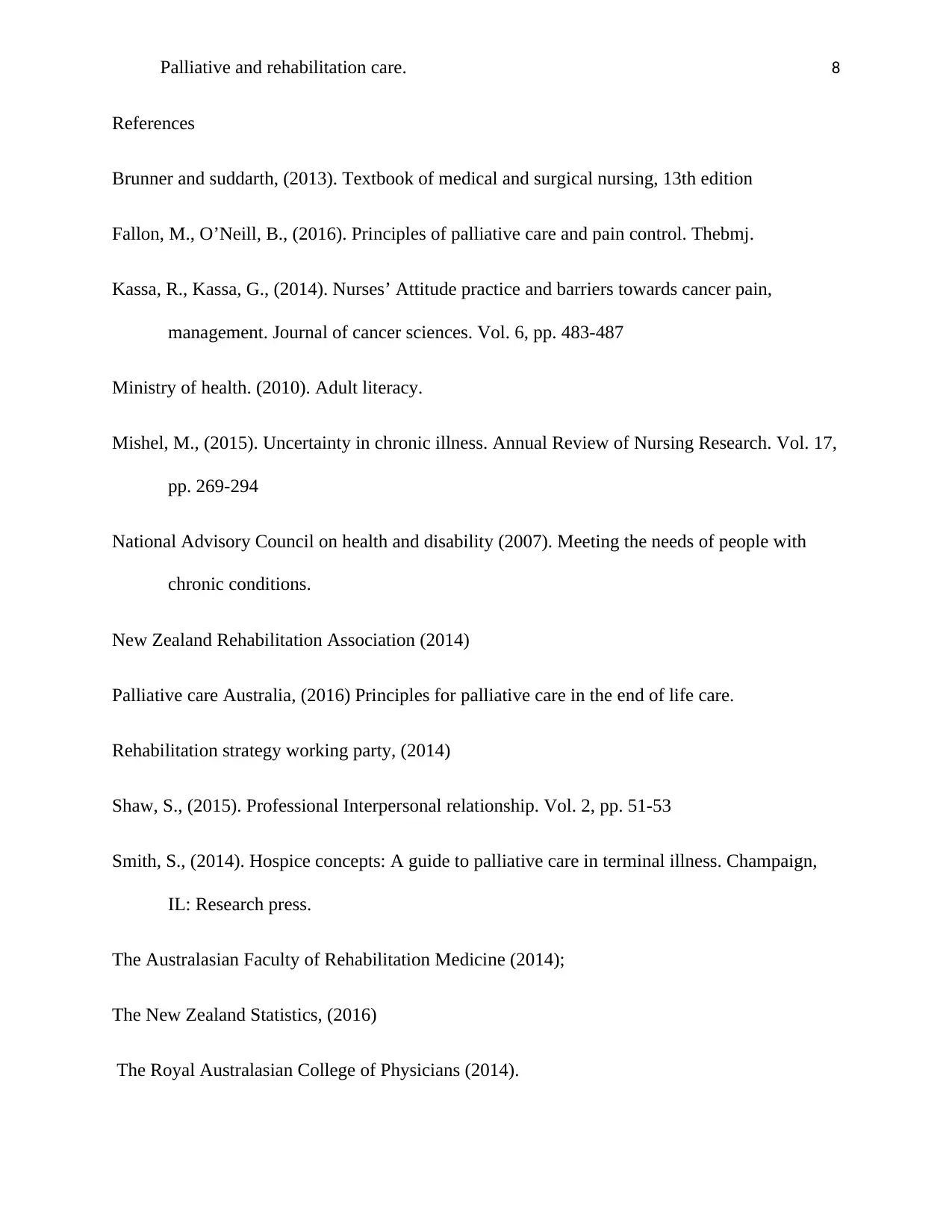
Palliative and rehabilitation care. 8
References
Brunner and suddarth, (2013). Textbook of medical and surgical nursing, 13th edition
Fallon, M., O’Neill, B., (2016). Principles of palliative care and pain control. Thebmj.
Kassa, R., Kassa, G., (2014). Nurses’ Attitude practice and barriers towards cancer pain,
management. Journal of cancer sciences. Vol. 6, pp. 483-487
Ministry of health. (2010). Adult literacy.
Mishel, M., (2015). Uncertainty in chronic illness. Annual Review of Nursing Research. Vol. 17,
pp. 269-294
National Advisory Council on health and disability (2007). Meeting the needs of people with
chronic conditions.
New Zealand Rehabilitation Association (2014)
Palliative care Australia, (2016) Principles for palliative care in the end of life care.
Rehabilitation strategy working party, (2014)
Shaw, S., (2015). Professional Interpersonal relationship. Vol. 2, pp. 51-53
Smith, S., (2014). Hospice concepts: A guide to palliative care in terminal illness. Champaign,
IL: Research press.
The Australasian Faculty of Rehabilitation Medicine (2014);
The New Zealand Statistics, (2016)
The Royal Australasian College of Physicians (2014).
References
Brunner and suddarth, (2013). Textbook of medical and surgical nursing, 13th edition
Fallon, M., O’Neill, B., (2016). Principles of palliative care and pain control. Thebmj.
Kassa, R., Kassa, G., (2014). Nurses’ Attitude practice and barriers towards cancer pain,
management. Journal of cancer sciences. Vol. 6, pp. 483-487
Ministry of health. (2010). Adult literacy.
Mishel, M., (2015). Uncertainty in chronic illness. Annual Review of Nursing Research. Vol. 17,
pp. 269-294
National Advisory Council on health and disability (2007). Meeting the needs of people with
chronic conditions.
New Zealand Rehabilitation Association (2014)
Palliative care Australia, (2016) Principles for palliative care in the end of life care.
Rehabilitation strategy working party, (2014)
Shaw, S., (2015). Professional Interpersonal relationship. Vol. 2, pp. 51-53
Smith, S., (2014). Hospice concepts: A guide to palliative care in terminal illness. Champaign,
IL: Research press.
The Australasian Faculty of Rehabilitation Medicine (2014);
The New Zealand Statistics, (2016)
The Royal Australasian College of Physicians (2014).
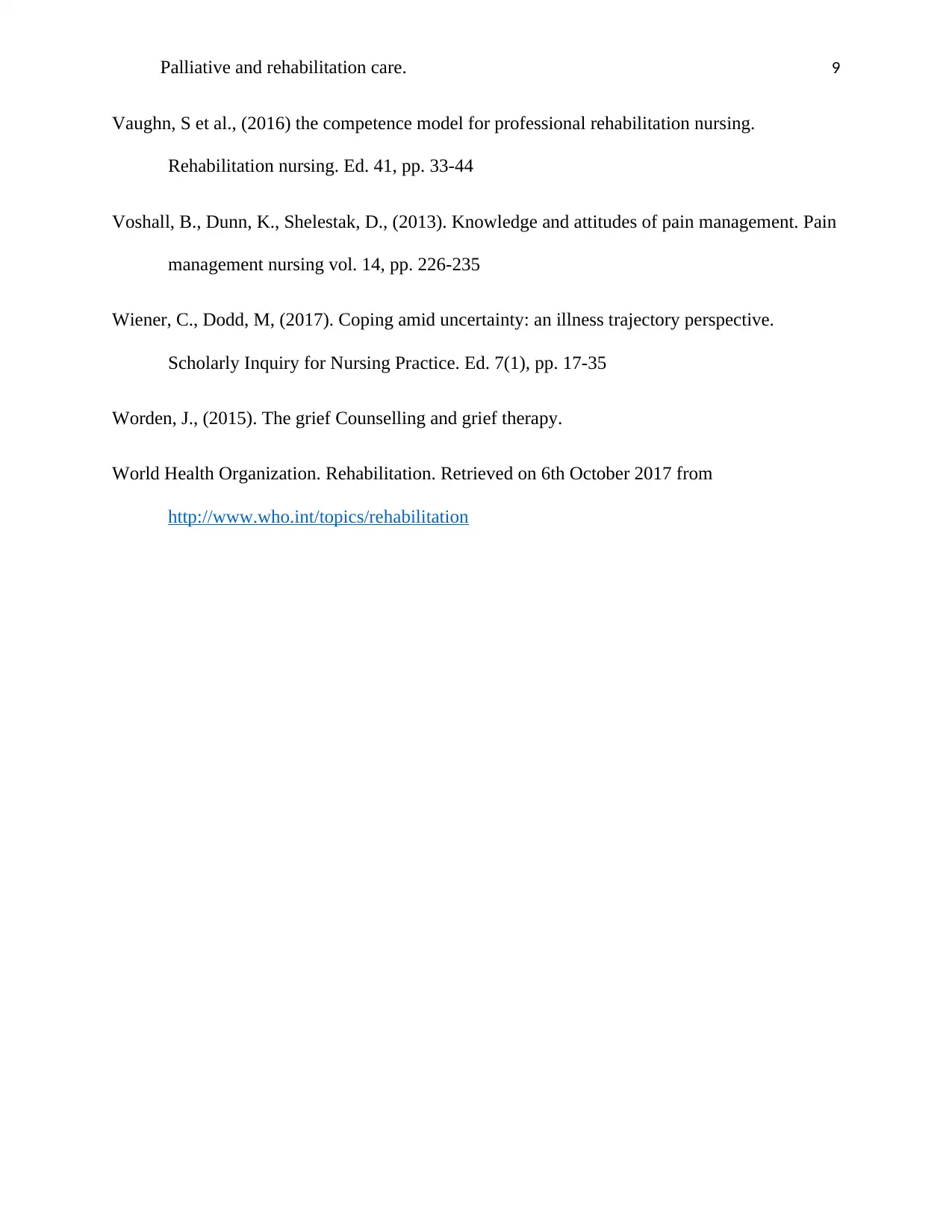
Palliative and rehabilitation care. 9
Vaughn, S et al., (2016) the competence model for professional rehabilitation nursing.
Rehabilitation nursing. Ed. 41, pp. 33-44
Voshall, B., Dunn, K., Shelestak, D., (2013). Knowledge and attitudes of pain management. Pain
management nursing vol. 14, pp. 226-235
Wiener, C., Dodd, M, (2017). Coping amid uncertainty: an illness trajectory perspective.
Scholarly Inquiry for Nursing Practice. Ed. 7(1), pp. 17-35
Worden, J., (2015). The grief Counselling and grief therapy.
World Health Organization. Rehabilitation. Retrieved on 6th October 2017 from
http://www.who.int/topics/rehabilitation
Vaughn, S et al., (2016) the competence model for professional rehabilitation nursing.
Rehabilitation nursing. Ed. 41, pp. 33-44
Voshall, B., Dunn, K., Shelestak, D., (2013). Knowledge and attitudes of pain management. Pain
management nursing vol. 14, pp. 226-235
Wiener, C., Dodd, M, (2017). Coping amid uncertainty: an illness trajectory perspective.
Scholarly Inquiry for Nursing Practice. Ed. 7(1), pp. 17-35
Worden, J., (2015). The grief Counselling and grief therapy.
World Health Organization. Rehabilitation. Retrieved on 6th October 2017 from
http://www.who.int/topics/rehabilitation
⊘ This is a preview!⊘
Do you want full access?
Subscribe today to unlock all pages.

Trusted by 1+ million students worldwide
1 out of 9
Related Documents
Your All-in-One AI-Powered Toolkit for Academic Success.
+13062052269
info@desklib.com
Available 24*7 on WhatsApp / Email
![[object Object]](/_next/static/media/star-bottom.7253800d.svg)
Unlock your academic potential
Copyright © 2020–2025 A2Z Services. All Rights Reserved. Developed and managed by ZUCOL.




